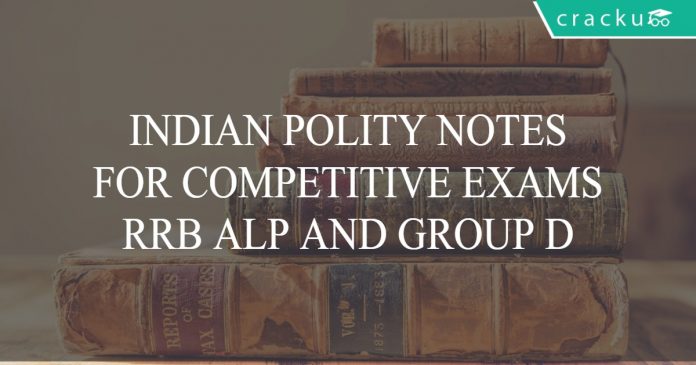Indian Polity Constitution of India PDF Notes:
We have given Indian polity notes for Competitive exams. You can download this polity PDF useful for all competitive exams of UPSC (Civil services including IAS), SSC CGL, TNPSC etc…
All the important notes on Indian constitutions, needed for all competitive exams.
Download Indian Polity – Constitution Notes PDF
Download Indian Polity Notes-2 PDF
Download Current affairs PDF
Download Static GK Capsule PDF
CONSTITUTION OF INDIA PDF
- Constitution of India is the World’s Longest written constitution of any sovereign Country in the world
- Constitution of India contains 448 Articles in 25 Parts, 12 Schedules and 101 Amendments till date.
- The Temporary Chairman of the first meeting of the Constituent Assembly held on 9 December 1946 is Sachchidananda Sinha
- The Oldest constitution in the world known today is the constitution of United States of America
- The Idea of Indian Constitution of was given by Dr B R Ambedkar who was the Chairman of the Draft Commission set up by the constituent assembly in 1947 to prepare the draft of the constitution. The Drafting Commission constituted a panel of 7 Members
- Krishnaswamy Ayyar
- Gopalaswamy Ayyangar, Alladi
- Saadullah
- Madhava Rao (replaced B.L. Mitter),
- T. Krishnamachari (replaced Dr. D.P. Khaitan after his Death)
- M. Munshi
- The Constitution of India is adopted by the Constituent assembly on 26th November, 1949 and the Constitution of India came into force on 26th January, 1950
- The Cabinet Mission to India in 1946 headed by Lord Pethick Lawrence was aimed to discuss the transfer of power from the British government to the Indian leadership and granting it independence.
- The Constitution of India which was framed by the Constituent assembly which was set up in 1946
- “Samvidhan Divas” or constitution day is observed every year in India on 26 November to commemorate the adoption of constitution on 26 November 1949
- Supreme Court acts as guardian of constitution by exercising Writs Jurisdiction, Appellate Jurisdiction and Power of Judicial Review
- Pingali Venkayya designed the present day National Flag and adopted during the constituent assembly meeting on 22 July 1947
Modern Indian History PDF Notes
- Rajendra Prasad is the President of the Constituent Assembly.
- The two prominent female leaders who played a key role in the drafting of the constitution of India are Dakshayani Velayudhan and Vijaya Lakshmi Pandit
- The President of India is called the First Citizen of India as per the Constitution of India
- The Committee on Fundamental Rights and Minority Rights of the Constituent Assembly was headed by Sardar Vallabhbhai Patel.
Following are the Important Sub Committees of the Constituent Assembly and their Heads:
| Dr Rajendra Prasad | Steering Committee
Finance and Staff Committee Adhoc Committee on National Flag Committee on Rules of Procedure |
| Jawaharlal Nehru | Union Constitution Committee
Union Powers Committee States Committee |
| B R Ambedkar | Drafting Committee |
| Sardar Vallabhbhai Patel | Advisory Committee on Fundamental Rights, Minorities and Tribal and Excluded Areas |
| JB Kripalani | Fundamental Rights Sub-Committee |
| GV Mavalankar | Committee on the Functions of the Constituent Assembly |
| KM Munshi | Order of Business Committee |
| HC Mookherjee | Minorities Sub-committee |
| Alladi Krishnaswami Ayyar | Credential Committee |
| B Pattabhi Sitaramayya | House Committee |
- For the first time in India, Indian Councils Act 1909 has legitimized the elections of Indians to the various legislative councils in India
- Government of India Act, 1935 has given the representation to Indians for the first time in Legislation
- The first session of the constituent assembly was held in the “Constitution Hall” – presently “The Central Hall of the Parliament House” in New Delhi on December 9th 1946
- In June, 1948 – Clement Attlee the Prime Minister of England in 1948 announced the transfer of Power to Indians
- Preamble was called the Soul of the Indian Constitution by Thakurdas Bhargav
- Preamble to the Constitution of India is a brief introductory statement that sets out the guiding purpose and principles of the document is Proposed by Jawaharlal Nehru before the Drafting Committee of the Constitution on 13 December 1946
- Preamble was called the Political Horoscope of the Indian Constitution by K M Munshi
- The strength of the constituent Assembly at the time of adoption of the constitution of India was 299
- The members of the constituent assembly were elected Indirectly by Legislatures of Provincial Assemblies and nominated by the rulers of the Princely states
- The Constituent Assembly itself became the Parliament of India.
- Government of India Act is the last constitution of the British India which lasted till 1947
- The First General Elections of Independent India were held in the Year 1952
- Beohar Rammanohar Sinha and Nandalal Bose are the one of the prominent Artists from Shantiniketan who had Hand Written the Constitution of India.
Download Static GK Capsules PDF
| First President of Independent India | Dr Rajendra Prasad |
| First Prime Minister of Independent India | Jawaharlal Nehru |
| First Education Minister of Independent India | Maulana Abdul Kalam Azad |
| First Home of Independent India | Sardar Vallabhbhai Patel |
| First Foreign Minister of Independent India | Jawaharlal Nehru |
| First Commerce and Industry Minister of Independent India | Syama Prasad Mukherjee |
| First Finance Minister of Independent India | Shanmukham Chetty |
| First Health Minister of Independent India | Amrit Kaur |
| First Indian Governor General of Independent India | C Rajagopalachari |
- The British Monarch and president of India have the same constitutional authority.
- The Real Powers of the state in a Parliamentary form of Government lies with the Council of Ministers headed by the Prime Minister of the Country
- It took 2 Year 11 Months and 18 Days to Finalize the constitution from the date of Planning a Drafting Committee
- The Directive Principles of State Policy mentioned in the Indian Constitution are important Principles Government has to keep in mind while formulating a new policy
- The Parliament of India is a Bicameral Legislature with two legislatures: Rajya Sabha and Lok Sabha
- Seven States in India have Bicameral Legislatures, they are
- Andhra Pradesh
- Telangana
- Bihar
- Jammu-Kashmir
- Karnataka
- Maharashtra
- Uttar Pradesh
- The two State Legislatures are Legislative Assembly and Legislative Council.
- The Indian Constitution has been best described as the “Lawyer’s Paradise” by the British Lawyer” Ivor Jennings”
- Idea of Preamble has been borrowed by the Indian Constitution from the Constitution of USA.
| Government of India Act – 1935 which is the last constitution of British India lasted till 1947. All Acts before this act are called as – East India Company Acts |
- The Total members of the constituent assembly were 385, after Independence the number came down to 299.
- The Comptroller Auditor General of India controls the entire financial system of the Union as well as the States, though he is appointed by the President, the Comptroller and Auditor- General can be removed only on an address from both Houses of Parliament on the ground of proved misbehavior or incapacity.
- Comptroller Auditor General is mentioned in the Article 148-151 of the Constitution of India
| Present Comptroller Auditor General of India | Rajiv Mehrishi |
- The Original copy of the book of Constitution of India is preserved in a Helium Filled Case of the Library of the Parliament of India
- The President is elected by the members of an electoral college consisting of the elected members of both the Houses of Parliament and the elected members of the Legislative Assemblies of States and the Union Territories of Delhi and Pondicherry
- The President may also be removed before the expiry of the term through impeachment for violating the Constitution of India by the Parliament of India. The process may start in either of the two houses of the Parliament. The house initiates the process by levelling the charges against the President.
- The Vice-President is elected by an Electoral College, which consists of the members of the Lok Sabha and Rajya Sabha
- It is mentioned in the constitution of India that the Vice-President of India can be removed by a resolution of the Rajya Sabha passed by an absolute majority (more than 50% of total membership ) and agreed to by a simple majority (50% of present and voting members) of the Lok Sabha
- The Constitution of India was majorly derived from Government of India Act 1935
- However, certain MAJOR features were borrowed from many Constitutions of the World.
Download Current Affairs Notes PDF
Indian constitution and Featured Borrowed:
| Constitution of USA | Fundamental Rights
Judicial Review Preamble |
| Constitution of Britain | Single Citizenship
Bicameral Parliamentary Procedure |
| Constitution of Germany | Provisions related to Suspension of Fundamental Rights of Citizens during Emergency |
| Constitution of Ireland | Directive Principles of State Policy
Presidential Election procedure |
| Constitution of Canada | Supreme Court’s advisory Jurisdiction |
Important Articles of the Indian Constitution are compiled as:
| PARTS | ARTICLES | SUBJECT |
| I | 1-4 | THE UNION AND ITS TERRITORY |
| II | 5-11 | CITIZENSHIP |
| III | 12-35 | FUNDAMENTAL RIGHTS |
| IV | 36-51 | DIRECTIVE PRINCIPLES OF STATE POLICY |
| V | 51-A | FUNDAMENTAL DUTIES |
| 79-122 | PARLIAMENT | |
| 148-151 | COMPTROLLER AND AUDITOR GENERAL OF INDIA | |
| 168-212 | STATE LEGISLATURE | |
| 213 | LEGISLATURE POWERS OF THE GOVERNOR | |
| 214-231 | HIGH COURTS IN THE STATE | |
| 239-241 | UNION TERRITORIES | |
| 243-243(O) | THE PANCHAYATS | |
| X | 244 – 244(A) | THE SCHEDULED AND TRIBAL AREAS |
| XV | 324-329 | ELECTIONS |
| XVIII | 352-360 | EMERGENCY PROVISIONS |
| XX | 368 | AMENDMENTS OF THE CONSTITUTION |
| XXI | 369-392 | TEMPORARY, TRANSITIONAL AND SPECIAL PROVISIONS |
| IMPORTANT ARTICLES OF THE INDIAN CONSTITUTION | |
| ARTICLE 14 | EQUALITY BEFORE LAW |
| ARTICLE 17 | ABOLITION OF UNTOUCHABILITY |
| ARTICLE 21 | PROTECTION OF LIFE AND PERSONAL LIBERTY |
| ARTICLE 21A | RIGHT TO EDUCATION |
| ARTICLE 23 | PROHIBITION OF TRAFFIC IN HUMAN BEINGS AND FORCED LABOUR |
| ARTICLE 44 | UNIFORM CIVIL CODE FOR ALL CITIZENS |
| ARTICLE 48A | Protection and improvement of environment and safeguarding of forests and wild life |
| ARTICLE 50 | SEPERATION OF JUDICIARY FROM EXECUTIVE |
| ARTICLE 51 | PROMOTION OF INTERNATIONAL PEACE AND SECURITY |
| ARTICLE 51 | ELECTION OF PRESIDENT |
| ARTICLE 66 | ELECTION OF VICE- PRESIDENT |
| ARTICLE 72 | Power of President to grant pardons, etc. and to suspend, remit or commute sentences in certain cases |
| ARTICLE 74 | COUNCIL OF MINISTERS TO AID AND ADVISE THE PRESIDENT |
| ARTICLE 76 | ATTORNEY GENERAL OF INDIA |
| ARTICLE 79 | CONSTITUTION OF PARLIAMENT |
| ARTICLE 80 | RAJYA SABHA-COMPOSITION OF THE COUNCIL OF STATES |
| ARTICLE 81 | LOKSABHA-COMPOSITION OF HOUSE OF PEOPLE |
| ARTICLE 124 | ESTABLISHMENT AND CONSTITUTION OF SUPREME COURT OF INDIA |
| ARTICLE 300A | RIGHT TO PROPERTY |
| ARTICLE 315 | PUBLIC SERVICE COMMISSIONS FOR THE UNION AND THE STATES |
| THE VOTING AGE OF THE ELECTORATE WAS REDUCED FROM 21 YEARS TO 18 YEARS BY THE 61ST CONSTITUTIONAL AMENDMENT IN 1988 | |
| RIGHT TO EDUCATION OF CHILDREN FROM THE AGE OF 6 YEARS TO 14 YEARS WAS MADE A FUNDAMENTAL RIGHT BY THE 86TH AMENDMENT IN 2002 | |
Medieval Indian History PDF Notes
Ancient Indian History PDF Notes
FUNDAMENTAL RIGHTS |
FUNDAMENTAL DUTIES |
| v RIGHT TO FREEDOM | v To abide by the Constitution and respect its ideals and institutions, the National Flag and the National Anthem |
| v RIGHT AGAINST EXPLOITATION | v To cherish and follow the noble ideals which inspired our national struggle for freedom |
| v RIGHT TO FREEDOM OF RELIGION | v To uphold and protect the sovereignty, unity and integrity of India |
| v RIGHT TO CONSTITUTIONAL REMEDIES | v To defend the country and render national service when called upon to do so |
| v CULTURAL AND EDUCATIONAL RIGHTS | v To promote harmony and the spirit of common brotherhood amongst all the people of India transcending religious, linguistic and regional or sectional diversities; to renounce practices derogatory to the dignity of women |
| v RIGHT TO FREEDOM OF RELIGION | v To value and preserve the rich heritage of our composite culture |
| v There are SIX Fundamental Rights of the Citizens mentioned in the Constitution of India
v There are 11 Fundamental Duties envisaged for the Citizens of India in the Constitution of India v The 12th fundamental duty has been added to the Constitution of India by the 86th constitutional amendment in 2002 v Fundamental Rights are written in Part III and Articles 12-35 of the Indian Constitution v Fundamental Duties are written in Part IV-A and Article 51-A of the Indian Constitution |
v To protect and improve the natural environment including forests, lakes, rivers, wildlife and to have compassion for living creatures |
| v To develop the scientific temper, humanism and the spirit of inquiry and reform | |
| v To safeguard public property and to abjure violence | |
| v To strive towards excellence in all spheres of individual and collective activity, so that the nation constantly rises to higher levels of endeavor and achievement | |
| v Who is a parent or guardian, to provide opportunities for education to his child, or as the case may be, ward between the age of six to fourteen years | |
| v We the people of India hereby adopt that to make India a safer place to live we had to be clean and make our surrounding clean and not to hurt anybody physically and mentally |
- The Attorney General of India is the first Law Officer of the Government of India who gives advice on legal matters and performs other duties of a legal character as assigned to him by the President
- Attorney General of India is mentioned in Article 76 of the Constitution of India
| Present Attorney General of India | K. K. Venugopal – 15th |
- The Solicitor General of India is below the Attorney General for India, who is the Indian government’s chief legal advisor, and its primary lawyer in the Supreme Court of India. The Solicitor General of India is appointed for the period of 3 year
- The Post of Solicitor General is not mentioned in the constitution of India and is merely statutory.
| Present Solicitor General of India | Ranjit Kumar |
- President is the head of both the Houses in India – Rajya Sabha and Lok Sabha
- The Rajya Sabha is the upper house of the Parliament of India.
- The members RajyaSabha are elected by the members of Legislative Assembly of respective states
- The Vice- President of India is the ex-officio of Chairman of Raja Sabha
- The maximum Strength of the of Rajya Sabha is limited by the Constitution under Article 79 to a maximum of 250 members
- Lok Sabha is the Lower house of India’s bicameral Parliament under Article 79 of the Indian Constitution of India
- Maximum strength of the Loksabha is 545 (543 elected + 2 Nominated from the Anglo-Indian Community by the President)
- The Supreme Court of India is the highest judicial forum and final court of appeal under the Constitution of India, the highest constitutional court, with the power of constitutional review mentioned, the strength of the Supreme Court of India is 31 (Chief Justice of India and 30 Judges.
- The First Rajya Sabha MP to become the Prime Minister of the country was Indira Gandhi
- Advocate General appointed by the Governor of the state is the highest law officer of the State.
- The Chairman of the Union Public Service Commission is appointed by the President of India.
- The National Capital Territory of Delhi is constituted by the 69th Amendment to the Constitution of India.Hope this polity of India PDF notes will be useful for your railway RRB, UPSC, SSC CGL, TNPSC and other competitive exam preparation.






[…] Indian Polity – Constitution of India PDF – 8th March 2018 […]
[…] Indian Polity PDF Notes […]
[…] Indian Polity PDF Notes […]